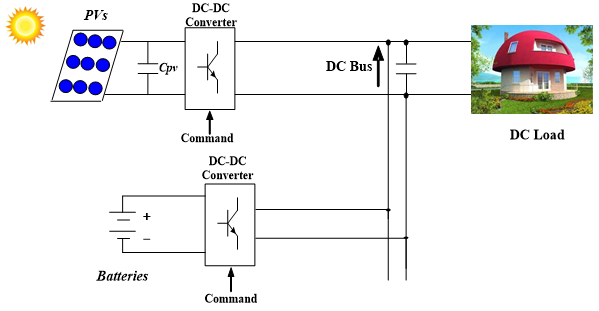Optimal design of stand-alone photovoltaic system based on battery storage system: A case study of Borj Cedria in Tunisia
DOI:
https://doi.org/10.18686/cest.v1i1.28Keywords:
PV; system’s site; optimum tilt angle; SAPS; PV-GIS site; PVsyst software; technical performance; experimental setupAbstract
This work dealt with the optimal design of a stand-alone photovoltaic system (SAPS) based on the battery storage system and assessed its technical performance by using a PVsyst simulation. Specifically, this study was carried out to determine the optimal orientation and tilt angle of a solar panel for collecting maximum solar radiation. Borj Cedria, Tunisia, was taken as a case study site to investigate the optimum tilt angle using PVsyst and to estimate the global solar irradiance using the PV-GIS. The proposed system produced 1314 kWh of energy for the load, which is considered technically suitable for this area, thanks to the system’s performance ratio of 58.3% and high specific efficiency generation, as well as a solar fraction of about 92.5%. From an economic point of view, the SAPS can save more than TND44,000 (12,991 Euros) per year from the purchase of the grid system’s energy, and from the aspect of sustainability, 66.24 kg of CO2 emissions annually can be avoided by utilizing the sun’s energy. Furthermore, an efficient solar panel use requires its characteristics to be identified under various conditions. An original experimental setup was carried out in a photovoltaic laboratory to identify the photovoltaic characteristics of the SAPS. Experimental and simulation results performed using PSIM software were in good agreement, which showed the experimental setup’s effectiveness.

Downloads
Published
How to Cite
Issue
Section
License
Copyright (c) 2023 Safa Slouma, Wael Boulaares, Somnath Maity, Abdelmajid Jemni, Souheil El Alimi

This work is licensed under a Creative Commons Attribution-NonCommercial 4.0 International License.
References
1. Schmidt J, Cancellaa R, Pereira AO. An optimal mix of solar PV, wind and hydro power for a low-carbon electricity supply in Brazil. Renewable Energy 2016; 85(C): 137–147.
2. Mariano JDA, Campos HM, Tonin FS, et al. Performance of photovoltaic systems: Green office’s case study approach. International Journal of Energy and Environment 2016; 7(2): 123–136.
3. Liu Z, Li Y, Xie J, et al. Optimum design for fixed grid connected photovoltaic array. Journal of Yunnan Normal University (Natural Sciences Edition) 2000; 20(6): 24–28.
4. Yang J, Mao J, Chen Z. Calculation of solar radiation on variously oriented tilted surface and optimum tilt angle. Journal of Shanghai Jiao Tong University 2002; 36(7): 1032–1036.
5. Yang G, Chen M, Chen Z. CAD method used in determining the optimum tilt angle of fixed PV arrays. Acta Scientiarum Naturalium Universitatis Sunyatseni 2008; 47(S2): 165–169.
6. Sun Y, Du X, Wang X, et al. Calculation of solar radiation and optimum tilted angle of fixed grid connected solar PV array. Acta Energiae Solaris Sinica 2009; 30(12): 1597–1601.
7. Li F, Zhao J, Duan S, et al. Evaluation of three models of monthly average total radiation on inclined surfaces and investigation of optimum tilt angle for array. Acta Energiae Solaris Sinica 2015; 36(2): 502–509.
8. Wang B, Shen Y. Discussion on the optimal tilt angle of solar installations from the perspective of resources. Solar Energy 2010; 159(7): 17–20.
9. Bouzguenda M, Al Omair A, Al Naeem A, et al. Design of an off-grid 2 kW solar PV system. In: Proceedings of the Ninth International Conference on Ecological Vehicles and Renewable Energies (EVER 2014); 25–27 March 2014; Monte-Carlo, Monaco. pp. 1–6.
10. Sharma V, Chandel SS. Performance analysis of a 190kWp grid interactive solar photovoltaic power plant in India. Energy 2013; 55: 476–485.
11. Mansur TMNT, Baharudin NH, Ali R. Performance analysis of self-consumed solar PV system for a fully DC residential house. Indonesian Journal of Electrical Engineering and Computer Science 2017; 8(2): 391–398. doi: 10.11591/ijeecs.v8.i2.pp391-398
12. Mansur TMNT, Baharudin NH, Ali R. A comparative study for different sizing of solar PV system under net energy metering scheme at university buildings. Bulletin Electrical Engineering and Informatics 2018; 7(3): 450–457. doi: 10.11591/eei.v7i3.1277
13. Nalini A, Sheeba PE, Rama ST, et al. Experimental setup for investigating the PV cells with distinctive aspects. In: Proceedings of 2018 4th International Conference on Electrical Energy Systems (ICEES); 07-09 February 2018; Chennai, India. pp. 369–374. doi: 10.1109/ICEES.2018.8443192
14. Van Dyk EE, Gxasheka AR, Meyer EL. Monitoring current-voltage characteristics and energy output of silicon photovoltaic modules. Renewable Energy 2005; 30(3): 399–411. doi: 10.1016/j.renene.2004.04.016
15. Treble FC. On-site measurement of the performance of crystalline silicon PV arrays. Renewable Energy 1994; 5(1–4): 275–280.
16. Benzagmont A, Martire T, Beaufils G, et al. Measurement of the I(V) characteristics of photovoltaic array by the capacitive load method for fault detection. In: Proceedings of 2018 IEEE International Conference on Industrial Technology (ICIT); 20–22 February 2018; Lyon, France. pp. 1031–1036. doi: 10.1109/ICIT.2018.8352320
17. Mahmoud MM. Transient analysis of a PV power generator charging a capacitor for measurement of the I–V characteristics. Renewable Energy 2006; 31: 2198–2206.
18. Muñoz J, Lorenzo E. Capacitive load based on IGBTs for on-site characterization of PV arrays. Solar Energy 2006; 80: 1489–1497.
19. Spertino F, Ahmad J, Ciocia A, et al. Capacitor charging method for I–V curve tracer and MPPT in photovoltaic systems. Solar Energy 2015; 119: 461–473.
20. Kuai Y, Yuvarajan S. An electronic load for testing photovoltaic panels. Power Sources 2006; 154: 308–313.
21. Meyer HS, de Souza Soares ÁM, de Araújo Neto OS, et al. An experimental setup to seek for maximum power point tracking of photovoltaic panels. Academic Journals 2013; 8(47): 2294–2297.
22. Slouma S, Baccar H. A control strategy for PV stand-alone applications. Journal of Physics Conference Series 2015; 596(1): 012010. doi: 10.1088/1742-6596/596/1/012010
23. Hailu G, Fung AS. Optimum tilt angle and orientation of photovoltaic thermal system for application in greater Toronto area, Canada. Sustainability 2019; 11(22): 6443. doi: 10.3390/su11226443
24. Bouabdallah A, Bourguet S, Olivier JC, Machmoum M. Photovoltaic energy for the fixed and tracking system based on the modeling of solar radiation. In: IECON 2013 - 39th Annual Conference of the IEEE Industrial Electronics Society; 10–13 November 2013; Vienna, Austria. pp. 1819–1824. doi: 10.1109/IECON.2013.6699408
25. Diop D, Drame MS, Diallo M, et al. Modelling of photovoltaic modules optical losses due to Saharan dust deposition in Dakar, Senegal, West Africa. Smart Grid and Renewable Energy 2020; 11(7): 89–102. doi: 10.4236/sgre.2020.117007
26. Vengatesh RP, Rajan SE. Investigation of cloudless solar radiation with PV module employing MATLAB–Simulink. Solar Energy 2011; 85( 9):1727–1734.
27. Iqbal M. An Introduction to Solar Radiation. Academic Press; 1983.




.jpg)
.jpg)

